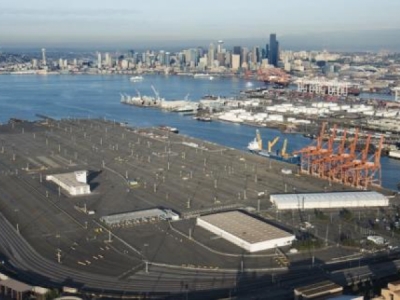
Posted on June 26, 2019
With initial construction on Terminal 5 just weeks away, Port of Seattle and Northwest Seaport Alliance officials set up shop in Jack Block Park Saturday to answer resident questions and provide information about the plans.
The project, which is slated to begin its pre-construction phase this July and last into 2023, constitutes a major overhaul of the terminal, which has sat empty since 2014. Led by the Northwest Seaport Alliance (NWSA), which is comprised of the Ports of Seattle and Tacoma, the project aims to modernize Terminal 5 to make it “big ship ready” to grow cargo volumes and maritime jobs in the Puget Sound region. Post-construction, the terminal will be able to handle ultra-large container ships with a capacity of up to 18,000 containers. A groundbreaking ceremony is scheduled for July 10.
Terminal 5 was the first container terminal in the Sound when it opened in 1964. Since then, it has undergone a number of changes to its configuration and usage, the latest of which will be the current renovation and large-scale modernization effort. The construction aims to “rehabilitate” the dock, said Mick Schultz, Port of Seattle’s external relations program manager. Members of the project team said that the dock and terminal upgrades will not only allow for larger ships to pass through the terminal, but also do so with less environmental impact due to the overall modernization of the docks and the installation of larger cranes.
“All over the world, container ships are getting larger,” Schultz said, “and we’re going to have to be able to handle those ships if we want to remain an active port.”
Costs for the project, estimated around $340 million, will be split between the Ports of Seattle and Tacoma, with Seattle taking on up to $30 million more of the cost if necessary, Schultz said. Modernization efforts will be led by Orion Group Holdings, Inc.
Since the project was announced, residents have expressed concerns about NWSA’s environmental mitigation measures for noise, traffic and air emissions — which would most directly affect West Seattle residents who live close to the terminal.
“One of the aspects for any kind of in-water construction is something known as ‘the fish window,’ and that’s when the salmon are coming through,” said Sean Eagan, the government affairs director for the Port of Tacoma, which is part of NWSA. “That puts limitations on when you can do the construction. … You’ve got a small window of opportunity.”
To counteract noise during the construction phases of the project, work will be limited to 7 a.m. to 10 p.m. on weekdays, and 9 a.m, to 10 p.m. on weekends and holidays. To protect migratory fish in the area, pile driving and in-water work is limited to Aug. 15 to Feb. 15, and is slated to be completed over the course of two years — from 8 a.m. to 5 p.m. on weekdays, and 9 a.m. to 5 p.m. on Saturdays and certain Sundays due to ensuing noise levels.
When construction on the project finishes in 2023, an operational noise management plan will be in place, Eagan said. The terminal will implement a rail quiet zone with fencing and crossing gates to reduce the need for train horns and set up a noise complaint hotline for residents.
All equipment used during construction will be required to meet Tier 2 or better for engine emission standards as dictated by the Environmental Protection Agency, and fine particulate matter emissions from the construction site will be capped at less than six tons per year. Other environmental and air quality considerations have been taken to limit emissions and pollution, said Graham VanderSchelden, a project manager on NWSA’s air quality and sustainable practices team.
When cargo operations resume, NWSA will work to attract ships with shore power capability — the provision of shoreside electrical power to a ship at berth, which allows its main and auxiliary engines to be shut down — and derive 90 percent of its electrical power from non-fossil fuel sources.
Bruce Gryniewski, a West Seattle resident who attended Saturday’s information event, said he was impressed by the Seaport Alliance’s plans, specifically when it comes to stormwater management and mitigation. The terminal will receive a custom stormwater treatment system to replace the temporary one being installed during construction, and the discharged water will meet environmental standards.
“I’m excited to see something happen with the terminal after so many years,” Gryniewski said. “It’ll be good for the port and for the community. Any time you have economic development and growth, you’ve got jobs. … Trade is a big part of our economy here, so increasing trade is really good.”
Source: westsideseattle.com





